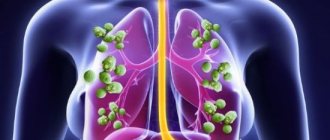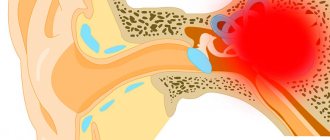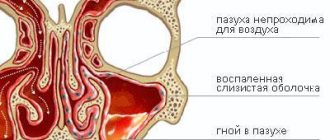Causes
The direct causative agent of otomycosis is the yeast fungus Candida. This microorganism is classified as opportunistic. Normally, it is present on human skin; the fungus exhibits its pathogenic properties only when the immune system is severely weakened.
The following unfavorable factors can be identified that can provoke the occurrence of ear candidiasis:
- purulent otitis;
- ear injuries and scratches;
- long-term treatment with antibiotics;
- hearing surgery;
- inflammatory diseases of the nasopharynx and maxillary sinuses;
- diabetes;
- taking immunosuppressants: corticosteroids, cytostatics, drugs for tumor chemotherapy;
- thyroid dysfunction;
- gastrointestinal diseases;
- pulmonary tuberculosis;
- HIV infection.
All these diseases and conditions lead to a weakening of the body’s defenses and activation of the fungus. However, you need to take into account that the Candida fungus loves moisture. Therefore, an increased risk of otomycosis is observed in those people whose working conditions are associated with exposure to water. These include dishwashers, laundry workers, as well as bath and sauna workers. The disease often develops in lovers of water treatments after water gets into the ear.
In addition, yeast fungus actively grows in a sweet environment. Therefore, otomycosis often affects confectionery workers and patients with diabetes mellitus. The fungus can affect both the outer and deeper parts of the hearing organ. Therefore, the symptoms and treatment of ear candidiasis largely depend on the area of infection.
What causes contribute to the development of ear candidiasis?
Most often, ear candidiasis develops under the influence of the following factors:
- long-term treatment of otitis media using antibacterial or hormonal drops;
- chronic forms of purulent otitis;
- surgical interventions on the hearing organs;
- microtrauma caused by improper ear care;
- wearing a hearing aid or headphones;
- negative environmental influences, expressed in excessive dust content in the air, excessive humidity and changes in atmospheric pressure;
- dysfunction of the immune system.
Most often, ear diseases accompany people who, by the will of fate, have to work in noisy industries. They also affect people who work in places where there are significant pressure changes, such as miners and divers.
Damage to the ear canal
If the affected area is limited to the external auditory canal, then the symptoms may be mild. Pain syndrome is often absent. The patient complains of discomfort, noise and congestion in the ear. The patient is bothered by severe unbearable itching in the ear canal.
If candidiasis is observed over a long period of time, then the patient develops more and more blocked ear infections. Doctors often mistake this for ordinary sulfur plugs and perform a rinse. Due to exposure to moisture, the fungus grows even stronger and the symptoms of the disease worsen.
In advanced cases, the disease becomes chronic. The patient is bothered by headache and distension in the ear canal. If ear candidiasis occurs as a result of otitis, then pain appears, increased pus secretion and increased temperature. Such symptoms indicate the spread of infection to the middle ear.
Signs of thrush in the ears
Candidiasis, no matter what part of the body it affects, is always accompanied by severe itching and burning. The ears are no exception, so if you experience persistent itching, you should immediately contact an otolaryngologist. Other signs may indicate the development of the disease:
- white-gray discharge from the ears, the smell and consistency of which resembles curdled milk;
- bleeding from the ears;
- dizziness and hearing loss;
- headache;
- the appearance of a rash in the form of red blisters filled with liquid on the auricle and the surrounding area;
- loosening of affected skin areas;
- pain in the ears, which is less pronounced than with other forms of otitis media;
- tinnitus and the sensation of a foreign object in the ear canal.
In children
Ear candidiasis in children most often occurs before the age of 5 years. Children are especially sensitive to fungal infections, and otomycosis is severe in them. The baby's health deteriorates sharply and his temperature rises. The child constantly touches the sore ear with his hands. There is hyperemia of the facial skin.
A white discharge similar to lumps of cottage cheese comes out of the ear canal. The ear canal and pinna become bluish and look swollen.
Diagnostics
Otomycosis is treated by an otolaryngologist. First of all, the specialist examines the ear using an otoscope. With external damage to the ear, redness of the ear canal and white films are noticeable, which can be easily removed. If a fungal infection has affected the middle ear, then profuse white discharge is noticeable.
To confirm the diagnosis, a microscopic examination of a smear from the ear canal is performed. This test must be taken again after the course of therapy to ensure the effectiveness of the prescribed treatment.
Drug treatment
Treatment of ear candidiasis begins with cleansing the ear canal of secretions. A solution of hydrogen peroxide is instilled into the ear, this helps to soften the masses. They are then removed with a cotton swab. This procedure must be carried out daily, as the ears quickly become contaminated with cheesy discharge. It is not recommended to wet the affected ear. In a humid environment, the fungus multiplies quickly. When taking water procedures and bathing, the ear canal should be plugged with a cotton swab and a rubber cap should be worn.
Treatment of ear candidiasis is carried out using antifungal solutions and ointments for topical use. The following drugs are prescribed:
- "Pimafucin";
- "Exoderil";
- "Batrafen";
- "Lamisil";
- "Candibiotic."
These medications suppress yeast activity.
In severe cases, doctors recommend taking oral antifungal tablets:
If the disease is difficult to treat, then the drug “Amphotericin-B” is prescribed intravenously. Along with antifungal therapy, the prescription of multivitamin complexes to strengthen the immune system is indicated.
The patient is advised to follow a diet during treatment. You need to exclude sweets and baked goods from your diet. Glucose is a favorable environment for the proliferation of fungi. You should try to consume as much fermented milk products as possible, as well as sour fruits and berries (lemon, cranberries, lingonberries).
Ear candidiasis: symptoms and treatment
Many people know about a disease called thrush (candidiasis). This fungal infection most often affects the genitals in adults and the mouth in children. In more rare cases, ear candidiasis occurs.
This disease is otherwise called otomycosis. This pathology is much more difficult to treat than ordinary otitis media. Without treatment, otomycosis can lead to significant hearing loss.
Next, we will look at the causes, symptoms and treatment methods of this disease.
Damage to the ear canal
If the affected area is limited to the external auditory canal, then the symptoms may be mild. Pain syndrome is often absent. The patient complains of discomfort, noise and congestion in the ear. The patient is bothered by severe unbearable itching in the ear canal.
If candidiasis is observed over a long period of time, then the patient develops more and more blocked ear infections. Doctors often mistake this for ordinary sulfur plugs and perform a rinse. Due to exposure to moisture, the fungus grows even stronger and the symptoms of the disease worsen.
In advanced cases, the disease becomes chronic. The patient is bothered by headache and distension in the ear canal. If ear candidiasis occurs as a result of otitis, then pain appears, increased pus secretion and increased temperature. Such symptoms indicate the spread of infection to the middle ear.
If the fungus affects the middle ear, it is always accompanied by shooting pain. The patient feels knocking and other sounds in the ears. Discharge in the form of a white cheesy mass leaves the ear canal.
At the same time, there is no feeling of stuffiness or plugs in the ear, since the discharge has a liquid consistency. In severe cases, the integrity of the eardrum is compromised. A fungal infection can spread to the skin around the ear.
Epidermal damage occurs on the chin, cheeks and neck.
Candidiasis after surgery
Sometimes ear candidiasis occurs after hearing surgery. For a long time after surgery, the patient experiences discharge from the ear canal. The postoperative wound does not heal for a long time. The use of antibiotics does not have any effect. The patient complains of noise and pain in the ear.
In children
Ear candidiasis in children most often occurs before the age of 5 years. Children are especially sensitive to fungal infections, and otomycosis is severe in them. The baby's health deteriorates sharply and his temperature rises. The child constantly touches the sore ear with his hands. There is hyperemia of the facial skin.
A white discharge similar to lumps of cottage cheese comes out of the ear canal. The ear canal and pinna become bluish and look swollen.
Diagnostics
Otomycosis is treated by an otolaryngologist. First of all, the specialist examines the ear using an otoscope. With external damage to the ear, redness of the ear canal and white films are noticeable, which can be easily removed. If a fungal infection has affected the middle ear, then profuse white discharge is noticeable.
To confirm the diagnosis, a microscopic examination of a smear from the ear canal is performed. This test must be taken again after the course of therapy to ensure the effectiveness of the prescribed treatment.
Drug treatment
Treatment of ear candidiasis begins with cleansing the ear canal of secretions. A solution of hydrogen peroxide is instilled into the ear, this helps to soften the masses. They are then removed with a cotton swab.
This procedure must be carried out daily, as the ears quickly become contaminated with cheesy discharge. It is not recommended to wet the affected ear. In a humid environment, the fungus multiplies quickly.
When taking water procedures and bathing, the ear canal should be plugged with a cotton swab and a rubber cap should be worn.
Treatment of ear candidiasis is carried out using antifungal solutions and ointments for topical use. The following drugs are prescribed:
- “Pimafucin”;
- “Exoderil”;
- "Batrafen";
- "Lamisil";
- “Candibiotic.”
These medications suppress yeast activity.
In severe cases, doctors recommend taking oral antifungal tablets:
- “Fluconazole”;
- “Natamycin”;
- “Nystatin”;
- “Intraconazole.”
If the disease is difficult to treat, then the drug “Amphotericin-B” is prescribed intravenously. Along with antifungal therapy, the prescription of multivitamin complexes to strengthen the immune system is indicated.
The patient is advised to follow a diet during treatment. You need to exclude sweets and baked goods from your diet. Glucose is a favorable environment for the proliferation of fungi. You should try to consume as much fermented milk products as possible, as well as sour fruits and berries (lemon, cranberries, lingonberries).
Conclusion
Otomycosis is a relatively rare disease. The fungus affects the ears only when the immune system is severely weakened. This pathology requires quite a long treatment. It is very important to see a doctor as early as possible, before the infection affects the deep parts of the ear and eardrum. This will help keep your hearing sharp.
Source: https://FB.ru/article/396220/kandidoz-uha-simptomyi-i-lechenie
Folk remedies
Traditional recipes for otomycosis can only be used as an addition to drug therapy. It is impossible to cure a fungal infection with home remedies alone.
Often, older people with ear inflammation instill boric alcohol into the ear canal. However, such a remedy is not always useful. Boric acid, of course, has bactericidal properties, but this drug cannot effectively cope with the fungus. In addition, boric alcohol causes a burning sensation and other side effects; it should never be used in the treatment of candidiasis in a child’s ear.
Doctors recommend using the following remedies at home:
- Apple vinegar. This product is used to treat the ear canal. Vinegar creates an unfavorable acidic environment for fungus.
- Onion and garlic. You need to squeeze the juice out of these vegetables and mix them in equal parts. The product is instilled into the sore ear at night.
- Celandine juice. It can also be used as ear drops.
ethnoscience
The most common folk remedies in the fight against candidiasis are the following methods:
- Celandine. The juice or decoction of the plant is instilled into the ear. Celandine relieves inflammation and reduces itching. Very often helps heal small ulcers.
- A mixture of onion and garlic juice. This remedy helps the body fight the source of the disease – the fungus, and, it is worth noting, this method is quite effective.
- Apple vinegar. This product is used to lubricate the upper layer of epithelium in the ear damaged by the fungus. Vinegar fights fungus and inflammation.
Traditional medicine is also taken in combination. It is advisable to combine these recipes with proven medications; since the patient may be allergic to some herbs and other components used in folk medicine, which, of course, will only complicate both the general condition of the patient and the course of the disease itself.
When treating ear candidiasis using any of the methods discussed above, you must adhere to a diet. It is recommended to exclude sweets, flour, fatty and salty foods. These products will interfere with the treatment of candidiasis.
In addition, doctors do not recommend smoking or drinking alcohol, or using antibiotics or hormonal drugs.
The diet includes as many vitamins, berries and vegetables as possible, which can improve and strengthen the immune system.
Causes of the disease
Fungi of the genus Candida are part of the normal microflora of the body. They are considered conditionally pathogenic, that is, under the influence of provoking factors they begin to actively multiply, affecting the mucous membranes and the surface of the epithelium. It is believed that the main danger is not the Candida fungus itself, but Aspergillus, which belongs to the penicillin series. It affects not only the outer ear, but also the middle ear, as well as the auditory canal.
The following reasons can trigger the development of the disease:
- weak immunity;
- treatment of chronic otitis;
- poor ear hygiene;
- direct introduction of fungus to the surface of the ear;
- diabetes;
- frequent pressure changes;
- high concentration of dust and noise in the environment;
- the result of surgery;
- oral or topical antibiotics;
- using headphones or hearing aids;
- water getting into the ear canal.
Excessive hygiene can also lead to the development of candidiasis, since the protective function of the epidermis is weakened due to constant washing of the surface.
Most often, this disease affects young children who find it difficult to maintain thorough hygiene or who injure their ears with foreign objects. Also at risk are miners and employees of noisy industries.
About the disease
several types of in the world . One of them is ear candiosis. Outwardly, it resembles yeast-like fungi, so the second name for this disease is “yeast infection.”
It usually occurs after long-term use
of antibiotics or other causes.
Fortunately, this disease is quite rare in all ages. However, this disease cannot be ignored , as it causes severe complications. For example, otitis, which from external can develop into internal or purulent.
First of all, the disease forms on the outer area in the area of the auricle.
There are several reasons for the occurrence of this fungus in the ears:
- side effect of long-term use of antibiotics;
- the use of drops with glucocorticoids that cause ear irritation;
- lack of hygiene or, conversely, excessive removal of wax plugs;
- poor state of the body's immune system;
- mechanical trauma to the ear;
- strong pressure changes;
- disruption of the structure of the ear organ after surgical interventions;
- chronic inflammation;
- diabetes;
- otitis;
- using a hearing aid or frequent use of headphones.
However, the most common cause of candida in the ears is the frequent entry of water into the ear canal. Staying in the ear canal for a long time, in addition to fungal inflammation, the liquid can provoke serious health diseases in general.
Therefore, it is very important to wipe your ears dry after each contact with water, be it water procedures or after swimming in the pool, and in the summer - after lakes and reservoirs.
Symptoms of the disease
Therefore, when the first symptoms appear, it is important to start timely treatment.
It is not difficult to understand that a patient has developed a fungus, since it has clear symptoms :
- Bad feeling.
- Severe dizziness.
- Headaches that can last for a long time.
- Significant hearing impairment.
- Noise, squeaking, crackling in the ears.
- Burning sensation.
- In rare cases, bleeding occurs.
- Discharge of various colors, but most often white and yellow.
- Formation of ulcers.
The symptoms of the disease cause extreme discomfort to the patient. In addition to the listed signs, a curd-like discharge forms in the patient’s ears, which greatly irritates the skin of the ears.
Signs and symptoms
Ear candidiasis is the same manifestation of thrush, but with an unusual location. Its main symptoms are itching and burning, which also occur in the ear, which is a signal to contact an otolaryngologist. There are also other symptoms that distinguish the disease from other inflammations:
- Discharge from the ear. They may have a grayish or white tint and a cheesy consistency.
- Constant and intense itching in the ear, which is difficult to suppress.
- The appearance of a rash near the ear, which may be accompanied by blisters.
- Muffled pain in the ear.
- Headache, tinnitus and feeling of fullness.
- Decreased hearing function.
- With deep penetration of candidiasis, bleeding from the ear is possible.
It is not necessary that all the symptoms will be present; usually, the first thing a person does is see a doctor because his ear is itchy intolerably. In more advanced cases, there is pain and congestion.
How to recognize candidiasis in the ear: symptoms
The first manifestation that should alert you is almost constant itching. He should force you to contact a specialist as soon as possible. With the development of candidiasis the following also appear:
- Discharge from the ears of a white/gray color with a liquid or cheesy consistency;
- Burning in the ear canal area;
- Sores resembling weeping eczema (specific redness and blisters that burst) may be observed on the skin;
- Maceration of the skin (loosening it);
- Possible bleeding from the ear canal;
- Hearing impairment;
- Dizziness
- Headaches and migraines;
- Ear pain (their nature is weaker than with a bacterial infection);
- Feeling "overcrowded";
- Periodic tinnitus.
Treatment of ear candidiasis in adults
Ear candidiasis is easy to treat if detected in the early stages.
- local treatment with creams and ointments;
- hygiene procedures using special means;
- oral antifungal medications;
- physiotherapy;
- vitamin complexes to improve immunity.
It is important to start treatment in a timely manner, otherwise the fungal infection will spread to the internal organs and cause sepsis. If candidiasis is caused by surgery, additional treatment is required.
Surgical intervention
If the disease is ignored for a long time, candidiasis spreads not only to the parotid space, but also to the inner ear. It can cause a rupture of the eardrum and lead not only to hearing loss, but also penetrate into the blood and internal organs, causing blood poisoning and sepsis.
In complex cases of candidiasis, they resort to surgical removal of the fungus from internal organs and their treatment. Often candidiasis is a consequence of surgery. In particular, with prosthetics, in this case a repeat operation is required to remove the infected prosthesis and treat the affected areas.
Even more interesting:
Causes of sores on the labia
Yarina with folic acid
Drug therapy
Treatment with drugs is based on antimycotic drugs for internal and local use. The most popular drugs:
- Candibiotic – ear drops that have antimycotic, antibacterial, anti-inflammatory and analgesic effects. Treatment lasts up to 10 days; it is necessary to instill 5 drops in the ear four times a day.
- Lamisil cream for topical use. It is applied with a cotton swab into the ear cavity once a day. A couple of days after starting treatment, the patient feels a noticeable reduction in itching. It is important that the course of treatment lasts at least two weeks to avoid relapse. If therapy is interrupted, there is a possibility of proliferation of fungi that are resistant to the drug.
- Exoderil is sold in the form of ointments and solution. It not only has an antifungal effect, but also exhibits an antibacterial effect. It is often prescribed if ear candidiasis is accompanied by a bacterial infection. The use of the solution involves placing cotton wool with the drug in the ear for half an hour. The ointment is applied using a cotton swab. The duration of therapy is from two to four weeks. It is also important not to interrupt treatment, so as not to become resistant to the drug.
Features of treatment of ear candidiasis
Candibiotic is an effective antifungal and anti-inflammatory drug
The first rule in treating candidiasis is not to wet the affected ear. When swimming, you must put a protective cap on your head or plug your ear with cotton wool soaked in vegetable oil or baby cream. This will keep the ear canal dry and reduce fungal growth.
Cleaning the ear canals from fungal masses - ear toilet is carried out daily either by a doctor in a clinic, or by the patient himself using 3% hydrogen peroxide. 5-7 drops of solution are instilled into the sore ear, and the person lies on the opposite ear for 5-10 minutes. Then the head is tilted towards the affected area and the fungal masses are carefully cleaned out with cotton swabs.
Drug treatment:
- A good and effective modern drug for the treatment of ear candidiasis is Candibiotic. In addition to clotrimazole (an antifungal component), the drug contains beclomethasone, chloramphenicol and lidocaine. Such a powerful complex of drugs provides antifungal, anti-inflammatory, antibacterial and analgesic effects. The drug is instilled 4 times a day, 4-5 drops into the sore ear, then the patient either lies on the opposite ear for 20 minutes, or sits with his head bowed. This is necessary for more complete contact with the affected skin and achieving a better therapeutic effect. Duration of treatment is from 7 to 10 days.
- Lamisil cream is applied once a day using a cotton swab or at a doctor's appointment. A decrease in itching and pain is observed after the first days of using the cream, but this is not a reason to stop treatment. The course of therapy is 14 days; untimely cessation of use of the cream leads to relapse of the disease. There is also a threat of the growth of fungi resistant to the drug, which will complicate further treatment.
- Exoderil - solution and ointment - is also used to treat ear candidiasis. In addition to the antifungal effect, it also has an antibacterial effect, so it is advisable to use it for otomycosis complicated by a bacterial infection. The solution is injected onto a cotton pad into the ear canal and left for 20-30 minutes. The ointment is applied with a cotton swab. The course of treatment is long and ranges from 2 to 4 weeks, which should be taken into account when prescribing the drug. Exoderil should not be taken by patients who tend to quit treatment when they feel better. In these cases, alternative drugs are used.
- Batrafen is a powerful antifungal drug based on ciclopirox, which has a wide spectrum of activity. Apply 1-2 times a day to the skin of the sore ear for 2 weeks.
Ear candidiasis in children
Children are at risk for developing ear candidiasis, since their immunity is not yet strong and the structure of the ear is still developed.
Specifically the Eustachian tube, which connects the middle ear and throat. It weakly removes germs, which provokes the development of infection or fungal formations. A child may develop ear candidiasis in the following cases:
- weak immunity;
- frequent use of antibiotics;
- chronic diseases;
- frequent colds;
- taking hormonal medications;
- failure to comply with hygiene standards.
Children, just like adults, experience symptoms of itching, pain, and congestion. They may experience ear discharge. The only difficulty is the inability of a small child to tell what symptoms are bothering him. Therefore, it is important to contact an otolaryngologist if he is capricious and often fiddles with his ear. It is important not to delay visiting a doctor, as the structure of the ear and a weak eustachian tube can lead to sepsis of the inner ear or blood poisoning.
Treatment is local and comprehensive and should have an antimycotic, anti-inflammatory and analgesic effect. The effectiveness of therapy also lies in proper ear hygiene. If a child is diagnosed with ear candidiasis, you should pay attention to the state of the immune system, improve the quality of nutrition, drink a complex of vitamins and minimize the use of antibiotics.
Prevention measures
In order to avoid the occurrence of ear candidiasis, it is necessary to properly organize health support. Viral infections and other ear inflammations should be avoided; if antibiotics are necessary, care must be taken to take medications that support the normal microflora of the body.
Ear hygiene plays a leading role in the prevention of ear candidiasis. But this does not mean that you need to thoroughly wash your ears with soap every day, since this behavior weakens the surface of the epidermis and can provoke the development of fungus. But ignoring washing will not lead to anything good. After all, a large amount of dust, dirt and bacteria during microtrauma of the ear can cause inflammation. Hand hygiene should also be maintained to avoid direct contamination of the fungus.
Ear candidiasis is a disease that requires patience, since the disappearance of symptoms is not a sign of complete recovery. It is important to strictly follow all doctor’s recommendations to avoid relapse and development of resistance to the drugs used.
Ear candidiasis or fungal otitis is a disease that affects the external auditory canal, the middle ear cavity, and in severe cases, the postoperative cavity in the ear.
Causes of the disease
Fungal infection - causes of ear candidiasis
The cause of the disease lies in yeast-like fungi of the genus Candida. There are more than 150 species of fungi of this genus; they live in soil, air, water and live on the skin of a healthy person. Candida belongs to the opportunistic fungi - they lead to disease only in the presence of pathogenic factors.
How does infection occur: the fungus attaches to the skin of the ear and begins to actively multiply, forming colonies. Then the microorganism begins to penetrate deep into the skin, affecting the epidermis, which leads to disruption of the skin barrier function and the development of the inflammatory process.
Factors influencing the body's resistance to fungal invasion:
- A chronic, sluggish disease that reduces the body's immune response (tonsillitis, sinusitis, rheumatoid arthritis, gastric and duodenal ulcers).
- Immunodeficiency state (for example, after suffering from mononucleosis).
- Hormonal disorders (thyrotoxicosis).
- Metabolic disorders (diabetes mellitus).
- HIV infection.
- Tumor diseases and immunodeficiency after radiation and chemotherapy.
- Tuberculosis.
- Immunosuppression caused by taking corticosteroid drugs (systemic lupus erythematosus, rheumatoid arthritis).
- Taking large doses of antibiotics.
Traumatic damage to the skin of the ear is of great importance in the development of ear candidiasis, since trauma contributes to the rapid germination and proliferation of fungi. Active use of cotton swabs to clean the ear canal often results in scratches and abrasions in the ear, which, when accompanied by a fungal infection, leads to candidal otomycosis.
Frequent ear hygiene also leads to the development of the disease: many people try to wash and clean their ears every day.
Such manipulations lead to the complete removal of sulfur, which protects the skin from harmful external factors and microbes. But yeast-like fungi do not always lead to external otitis. To maintain their vital functions, several important factors are required: air, high humidity and a comfortable temperature. Fungi of the genus Candida are aerobes and cannot live without air. They also love high humidity and therefore begin to actively reproduce in the ear after bathing.
This fact is associated with the spread of the disease among sauna and bathhouse workers, dishwashers and housewives who wash a lot of dishes by hand. The human body temperature is acceptable for fungi, but with inflammation and an increase in local temperature, their growth increases. Since this group of microorganisms loves polysaccharides, pastry chefs and workers in confectionery factories often suffer from otomycosis.
Symptoms of the disease
Itching and discharge are signs of ear candidiasis
Candidal otomycosis is characterized by scant symptoms. The patient may complain of discomfort in the ear, nagging pain, lumbago, noise and congestion. But most often a person turns to an otolaryngologist with severe unbearable itching. The desire to scratch the ear is associated with irritation of nerve receptors by mushrooms and desquamation of the epidermis.
Pain with mycosis is much less common, in contrast to external otitis of another etiology. But if pain is present, it often causes inconvenience in the evening and at night. Many patients experience high sensitivity of the ear when trying to touch or pull back the auricle. Patients often complain of moisture and fluid in the sore ear.
With a long course of candidal otomycosis, ear congestion appears due to mechanical blockage of the ear canal by desquamated epidermal masses and fungal mycelium. Often, patients repeatedly come to the ENT specialist, have their ears washed with distilled water and sent home without suspecting an infection. Such manipulation can aggravate the process and activate the growth of fungal colonies.
If you repeatedly remove a white plug with loose wet masses, you must take a smear for mushrooms.
The long-term chronic course of the disease causes headaches on the side of the affected ear and a slight feeling of fullness in the ear. In the presence of chronic purulent otitis with a defect in the eardrum and periodic discharge from the ear, candidiasis is more pronounced. There is a shooting pain in the ear, behind the ear in the mastoid area, a rise in temperature, and increased suppuration when fungi grow into the middle ear.
Ear candidiasis: symptoms and treatment – Website about eye diseases and their treatment
19.01.2017, 16:03
Mycoses, fungal infections, are becoming more common these days. On our skin and mucous membranes, a balance is constantly maintained between normal and opportunistic bacteria. Often we don’t even think about whether this balance is preserved in our body or not.
And we begin to take action only when the disease manifests itself in all its glory. A lot of articles and publications are devoted to the treatment of intestinal candidiasis, candidal vaginitis and other types of candidiasis (thrush). However, the number of patients with ear candidiasis is increasing every year.
Ear candidiasis is a fairly common disease.
Description of the problem
The so-called fungal otomycosis (candidiasis of the ears) occurs quite often among the working population. Ear candidiasis most often develops; a bilateral process is a very rare occurrence. The widespread occurrence of thrush is associated with the reasons for its development:
- Treating the ears with a cotton swab.
- Penetration of water into the ears after swimming.
- Using hearing aids and improperly cleaning them.
- Uncontrolled use of antibiotics and hormonal drugs.
The remaining cases of thrush are associated with previous purulent otitis media, which was not properly treated.
Most often, otitis of the external ear is diagnosed; in patients with various concomitant diseases, the fungus can affect the middle and inner ear, and then otitis of these structures develops.
The main types of fungi that cause candidiasis are Candida and Aspergillus, these are yeast-like fungi and molds. But given that the causes of the development of thrush are untreated otitis media, then in addition to fungi, other pathogenic bacteria will be involved in the development of ear candidiasis.
Manifestations of the disease
A large number of studies have been conducted that have shown the most common complaints and symptoms of ear candidiasis. In addition to the symptoms listed below, nonspecific symptoms may occur when the ear is affected.
Often otomycosis accompanies purulent otitis, and purulent contents will be discharged from the ears.
There may be non-specific symptoms such as dizziness, a feeling of “fullness”, and in almost 100% of cases of thrush there is a change in the skin in the ear area.
Most cases when a patient visits an ENT doctor are accompanied by the following symptoms:
- In 100% of cases of thrush, there is discharge from the ear or ears.
- Complaints of noise in the affected ear.
- Ear pain and headache on the side of the affected ear.
- Itching in the ear and hearing loss.
Often ear candidiasis is accompanied by purulent otitis media.
How can you help?
Otitis media is a serious disease, as patients often come to the doctor when the symptoms of thrush are already pronounced.
Treatment of candidiasis is a very labor-intensive task, since, in addition to treating the main symptoms, it is necessary to direct treatment to correct the causes and factors that could cause thrush.
In the treatment of thrush, the main role is played by the attending physician, since only he can diagnose thrush based on the symptoms, and also select a drug sensitive to the fungus based on the studies performed.
For otitis externa, topical antifungal medications are used, they are produced in the form of a solution and cream. Otitis media is treated with general antifungal drugs. In this case, most often the duration of treatment for otitis ranges from two weeks to a month, however, a decrease in the severity of symptoms may occur after just a few days of use.
A big problem in the treatment of otitis externa is the change in skin condition that persists after treatment. Dermatologists recommend using corticosteroid ointments, but given that they are a risk factor for the development of candidiasis, this is not the best option.
Therefore, in the treatment of fungal mycoses, combination agents are increasingly used, which include antibacterial, antifungal components, as well as corticosteroids and anesthetics. These are well-known drugs: Clotrimazole, Gentamicin, Triderm and others.
However, these drugs contain an antibiotic, which can be ototoxic, that is, damage to the hearing aid occurs. Therefore, these drugs can only be used when thrush affects the outer ear. It is also undesirable to use medications in the form of ointments on your own for otitis media, since it will not be possible to properly treat the external auditory canal.
The drug can only be used if the outer ear is affected.
Solution of the problem
An excellent treatment method is Candibiotic drops.
These drops are the only combined product for topical use registered in the Russian Federation and have a large number of necessary properties: analgesic effect, anti-inflammatory, antifungal and antibacterial effect. The medicine is prescribed for the local treatment of otomycosis of the external ear. The composition of the drug includes:
- Clotrimazole is an antimycotic agent that destroys the cell membrane of fungi and thereby destroys them. Fungi that are not affected by this drug are very rare.
- Chloramphenicol is an antibacterial drug that destroys many bacteria and does not affect the structures of the ear.
- Beclomethasone is a hormonal drug.
- Lidocaine hydrochloride – has an analgesic effect.
The candibiotic is applied topically, 4-5 drops are dripped into the external auditory canal 3-4 times a day. The course lasts about a week.
What else can you do to make it easier?
Considering that treatment requires an integrated approach, physiotherapy, vitamin complexes, immunostimulants, and ear hygiene are additionally used to relieve symptoms.
Otomycosis is a serious disease that can potentially pose a serious health threat.
Do not self-medicate; therapy for ear candidiasis should be comprehensive with the selection of effective medications, which can only be done by the attending physician.
Source:
Ear candidiasis: symptoms, treatment, drops in the ears
Most people tend to think of candidiasis as a problem related to the human reproductive system, but ear candidiasis is also a very common problem that can affect both children and adults.
Features of candidiasis
Candidiasis is a disease of the skin and internal organs that can appear in humans due to infection by a fungus of the genus Candida.
Depending on where exactly the infection is localized, there are many types of this disease.
It is not possible to describe each of them; moreover, the exact classification is carried out by a dermatologist. Let us consider in detail the most common forms of the disease.
Fungal infection of the skin and mucous membranes can be:
- Oropharyngeal. Includes all the symptoms and characteristics of thrush and appears mainly in the oral cavity. In addition to decreased immunity, the cause of the appearance may be diabetes, smoking, or installed dentures.
- Skin. It is localized in the armpit, under the mammary gland, in the groin, on the head, arms, as well as feet and nail plates.
- Urogenital. This includes thrush (vaginal candidiasis) in women. May occur after childbirth or during pregnancy. In addition, the cause of urogenital candidiasis may be reduced immunity, as well as hormonal imbalance in the body.
Symptoms of candidiasis can be cured completely, but there are cases when the disease subsides, and over time makes itself felt again. Treatment for this problem takes a long time, but if you follow the instructions of your doctor, the disease can leave a person for a long time and may not return again.
Causes of ear candidiasis
Almost half of all diseases of the ENT organs are damage to the ear canal by infection - otomycosis. The cause of this condition of the ears can be various microorganisms and bacteria. The main and most common fungus is Candida. It is Candida that causes this fungal infection, which affects almost every third person on the planet.
For ear thrush, treatment is prescribed by an otolaryngologist; in most cases, the recovery process is long. In most cases, children are at risk, but this does not mean that ear candidiasis does not occur in adults.
It is impossible not to notice the onset of this disease. In addition to the fact that an infection begins to grow in a person’s ears, the pain in the affected area also increases in intensity.
Let's consider the reasons that can provoke the disease:
- Inflammatory processes associated with ear disease, for example, otitis media.
- Complications that arose after surgery in the ear area.
- Weak immunity.
- Failure to comply with ear hygiene rules.
- Various diseases associated with the ear canal that were not treated in time.
- Regular use of hearing aids that are inserted into the ear.
- Unfavorable environmental conditions that contribute to the development of fungus: dust and dirt in the room, dampness, etc.
Often the cause of candidiasis progressing to a more severe form with damage to the middle ear is the incorrect use of cotton swabs to clean the ears. The person, without realizing it, pushes the infection deep into the ear, opening the way for it to remove the protective layer of wax.
Symptoms
Symptoms of ear thrush include:
- Acute itching and discomfort in the affected area.
- Signs of ear irritation: swelling, redness, discharge from the ear canal.
- When the form is advanced, small ulcerations may appear with the formation of a crust.
- Decreased hearing, as well as signs of general fungal intoxication (low-grade body temperature, headaches, weakness, dizziness).
- Sharp pain when touching the ear, a feeling of the presence of a foreign object in the ear.
- Nonspecific symptoms that may be associated with the spread of a fungal infection to other organs (skin lesions around the ear, etc.).
Any infectious disease, no matter how insignificant it may seem, is often associated with a potential threat to human life. An untreated or undertreated infection can spread throughout the body and cause severe complications. If the disease reaches a dangerous stage, bleeding from the ear canal may occur, which will lead to loss of consciousness.
If you are faced with a fungal infection of the ear, first of all you need to contact an otolaryngologist who will take a swab from your ear for analysis and help you reliably determine what kind of infection you are dealing with and how to treat it.
Therapy
Treatment of this infectious disease requires an integrated approach. Ear drops will not help cope with the problem. The most you can achieve is to temporarily reduce the symptoms of the disease. In most cases, doctors offer several medications, as well as certain hygiene rules to combat this disease:
- First of all, patients who consult a doctor with an affected ear are prescribed local antifungal therapy consisting of ointments, creams and drops containing special substances that destroy the fungus. The most common drugs are Nizoral, Fluconazole, Nitamycin.
- In more advanced cases, antifungal drugs may be prescribed orally (usually orally). Typically, such treatment is indicated if there is a high probability of fungus penetrating deep into the ear canal. In most cases, doctors prescribe Levorin, Pimafucin.
- To relieve symptoms and alleviate associated discomfort, hygienic treatment of the affected ear is carried out with antiseptic, wound-healing, anti-inflammatory and analgesic agents. These include boric acid solution, silver nitrate and quinosol.
Source: https://cliniceye.ru/otit/kandidoz-uha-simptomy-i-lechenie.html
What does the ear look like when examined?
External candidal otomycosis
Examination of the ear cavity by an otolaryngologist
The skin of the ear canal is dry, cracked, and there are whitish or yellow-white fatty masses in the ear canal. In most cases, inflammation is localized in the bony part of the ear canal and on the eardrum. The skin is moderately hyperemic; in advanced cases, roller-like thickening of the skin and bright redness in the bony area are noted. Serous clear fluid is also visualized in the ear. More often, the eardrum is only slightly hyperemic, but in severe cases, infiltration appears and identifying marks disappear.
There is a second version of the picture upon examination: the external auditory canals are dry, slightly hyperemic, the passage is not narrowed. Dry white films are observed throughout the skin, which are easy to remove. The membrane is either not involved in the process or is slightly hyperemic.
If the patient does not seek treatment for a long time and there is a pronounced decrease in immunity, the fungus can spread beyond the ear. The skin behind the ear, chin, neck and chest is affected.
Middle ear candidiasis
Mycoses in this case are characterized by copious discharge from the ear in the form of cheesy masses. Otomycosis does not cause plugs in the middle ear because the discharge is too liquid.
The skin of the ear is hyperemic and abundant cheesy masses are also visible on it.
Often there are several perforations in the eardrum. There are small granulations on the membrane itself, which can be easily removed with a probe and cotton wool.
Useful video: the main causes of itching in the ears
Candidiasis of the postoperative ear cavity
Often, after extensive surgery on the ear, suppuration from the ear does not stop and epithelization occurs extremely slowly. Powerful antibacterial therapy fails and the patient continues to constantly go to the otolaryngologist with complaints of noise in the ear, discharge, itching and pain. Often the patient cannot sleep on the operated ear due to pain and increased sensitivity of the auricle.
When examined by a doctor, the surgical cavity is completely filled with cheesy discharge; the picture resembles a cholesteatoma lesion. When you try to clean the cavity, the masses come off easily, piece by piece, they are white or yellow. There is often a specific unpleasant odor.
Ear candidiasis in babies
Newborns and young children from 1 to 5 years of age are more susceptible to candidiasis among children. Due to the high reactivity of the body, symptoms of inflammation clearly manifest themselves: the temperature rises, the face turns red, the child rubs his ears, and constantly turns his head to the side.
Copious cheesy discharge appears from the ear. The ear canal swells sharply, the skin is macerated, bluish, and hot to the touch. Often the process quickly spreads to the auricle and the skin around the ear.
- Examination by an otolaryngologist.
- Collecting smears for fungal infection.
Smears should be taken before treatment and after treatment.
Ear candidiasis causes of development
First of all, it should be noted that ear candidiasis most often occurs in children, although it is possible that the disease can also appear in adults, under the influence of certain factors. And yet, childhood candidiasis affecting the ears is a fairly common disease that is not always recognized in the initial stage.
The causes of candidiasis can be:
- diseases associated with inflammatory processes in the auricle, such as otitis media and its consequences:
- the presence of candida fungus in the child’s body and untimely treatment of the disease;
- complications after ear surgery;
- weak immunity;
- failure to comply with hygiene rules, improper ear care, water ingress, small wounds through which the infection penetrates deep into the ear;
- wearing a hearing aid;
- incorrect temperature conditions in the room, the presence of a large amount of dust, high air humidity.
As with other types of candidiasis, a symptom of the onset of the disease may be increased itching in the ear area, especially inside.
Deep cleaning of the ears may make candidiasis worse
Very often, cleaning the auricle with cotton swabs can cause a deeper penetration of the infection, which results in inflammation of the middle ear and, as a result, the development of candidiasis in the ears. Doctors often warn that cotton swabs are not the best way to clean ears, and even if they are used, this must be done with great care so as not to further harm the ear canals. The wax in the ear protects against bacteria, so there is no need to clean it out completely.
During normal functioning of the body, excess sulfur is eliminated independently, without external intervention.
If cleaning of the auricle is carried out frequently, then the protection is impaired, which means the likelihood of any infectious disease becoming much higher.











